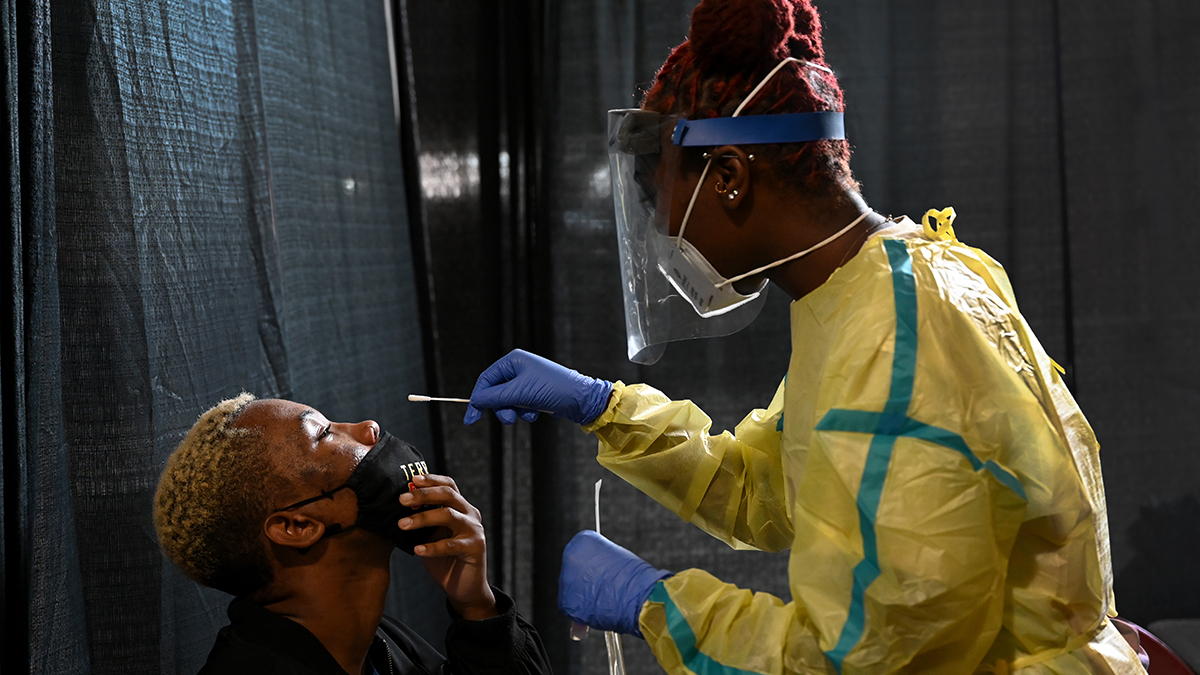Go here for the latest updates on July 22, 2020.
D.C., Maryland and Virginia have nearly doubled the average number of new coronavirus cases diagnosed each day since the beginning of July.
Those rising numbers are spurring disputes about how to move forward — or whether the region needs to take a step backward.
Health officials in five of Maryland's largest counties, including Prince George's and Montgomery, and Baltimore City requested the state health department revisit what activities are allowed under phase two of reopening, the Baltimore Sun reported.
D.C. Health Director LaQuandra Nesbitt said people should choose their activities more carefully.
"I think people have gotten very relaxed. We still need people to be very judicious about choosing their activities," Nesbitt said.
Metro ridership is up, indicating more people are leaving home. The beginning of the school year would only draw more people out into public, which is causing concerns.
Some teachers in D.C. Public Schools have pushed for a virtual-only start to the school year, saying it's not safe to return to buildings yet.
One group held a caravan protest outside the homes of council members and Mayor Muriel Bowser Monday. They brought signs reading "Black teachers matter" and "only when it's safe."
Fairfax County Public Schools on Tuesday upended their back-to-school plan after asking families to chose between all-online or hybrid learning for the fall.
The Fairfax County School Board voted Tuesday night in favor of the superintendent's recommendation to start the 2020-21 school year 100% online.
Here are some child care resources and coping tips as the pandemic drags on.
What the Data Shows
D.C., Maryland and Virginia have basically doubled their number of daily new cases since the beginning of July.
D.C. went from 34 new cases on average a day to 69; Maryland went from 369 to 755. Virginia is approaching an average of 1,000 cases a day, up from 510 on July 1.
Even Northern Virginia, which has slowed the spread of the virus in the past several weeks, has seen the average number of new cases a day tick up from around 200 to 230 on Tuesday.
Positivity rates, or the percentage of people who get a COVID-19 test that returns positive, are still under each area's goal of 10%. Virginia's is the highest at 7.7% over the past week and Maryland's is at 4.49%. D.C.'s was just 2% on Tuesday.
The District added 88 new cases on July 21, the highest number since June 4.
Hospitalizations remain stable in D.C. and are rising a bit in Maryland and Virginia, but are below the threshold for concern.
DC Struggles to Contain the Virus, Community Spread
Washington, D.C., announced a new metric it would use to gauge the severity of the coronavirus pandemic in the city. Right now, it's showing bad news.
Health officials will now release information on the percent of positive cases from quarantined contacts. That number will indicate how many people catch coronavirus from a friend, family member or another close contact who is already diagnosed with COVID-19.
When cases are connected to each other, it means the virus is more contained or under control, D.C. Health Director LaQuandra Nesbitt said.
D.C. wants the percent of positive cases from quarantined contacts to be high — above 60%. That would indicate that most newly sick people were already quarantined and not spreading the virus. It would also mean that health officials have a good idea where most new infections come from.
However, just 2.8% of coronavirus diagnoses on Tuesday are people who are already quarantined because they had close contact with a confirmed case.
The map below shows the number of coronavirus cases diagnosed per 1,000 residents.
Coronavirus Cases in DC, Maryland and Virginia
COVID-19 cases by population in D.C. and by county in Maryland and Virginia
Source: DC, MD and VA Health Departments
Credit: Anisa Holmes / NBC Washington
Local Coronavirus Headlines
- Fairfax County Public Schools has shifted to a 100%-online start to the school year, citing health data. Read more.
- The top health officials in five of Maryland's largest counties and Baltimore City have asked the state health department to bring back more restrictions amid a rise in coronavirus diagnoses. Read more.
- A federal judge refused Monday to temporarily block enforcement of Virginia Gov. Ralph Northam’s executive orders aimed at reducing COVID-19’s spread. Read more.
- The National Zoo is set to reopen Friday. Visitors over 6 years old need to wear a mask and everyone would need to reserve a free timed-entry ticket. Read more.
- The National Gallery of Art is partially back open starting Monday, July 20 with reservations, face masks and social distancing required. Read more.
- Fairfax County is working to fill several hundred contact tracing positions. Read more.
- The ACLU is asking D.C. city officials to require police to wear face masks while working. Read more.
- Nursing homes were required to start reporting COVID-10 data to the federal government nearly two months ago. A report by the News4 I-Team shows that eight local nursing homes still have not shared that information.
Reopening Tracker
- Virginia entered phase three reopening on July 1, loosening restrictions on restaurants, stores, gyms and pools. But Gov. Northam said more restrictions could be implemented if cases continue to grow.
- Prince George's County entered full phase two on June 23, allowing the MGM Casino and gyms to reopen.
- Washington, D.C., entered phase two on June 22, allowing indoor dining, gyms, libraries and houses of worship to reopen with restrictions.
- Montgomery County entered phase two on June 19, reopening with restrictions gyms, houses of worship, indoor dining and retail.
- Maryland entered phase two of reopening on June 10, permitting indoor dining, outdoor pools and outside amusements to reopen.
How to Stay Safe
There are ways to lower your risk of catching coronavirus. Here are the CDC guidelines.
- Wear a snug-fitting mask that covers your nose and mouth.
- Avoid being indoors with people who are not members of your household. The more people you are in contact with, the more likely you are to be exposed to COVID-19. If you are indoors with people you don’t live with, stay at least six feet apart and keep your mask on.
- Wash your hands often, especially after you have been in a public place.
Sophia Barnes, Andrea Swalec and Anisa Holmes contributed to this report



